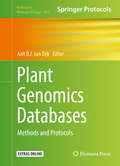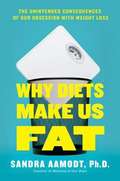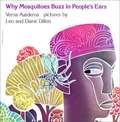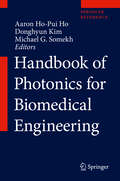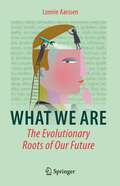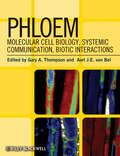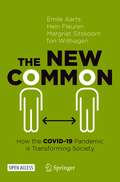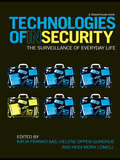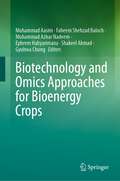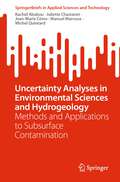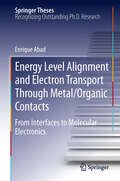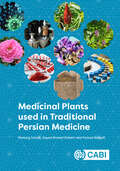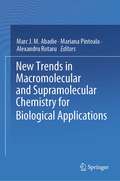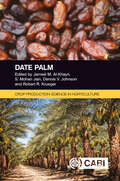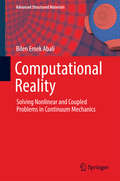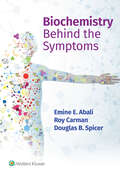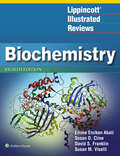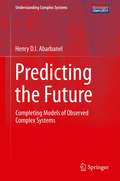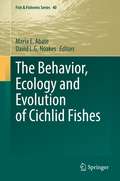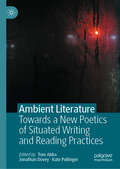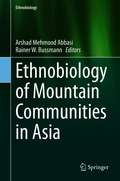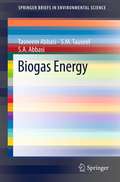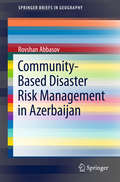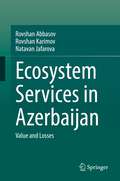- Table View
- List View
Plant Genomics Databases
by Aalt D.J van DijkThis volume introduces databases containing the results from the recent revolution in sequencing technologies. Chapters in Plant Genomics Databases: Methods and Protocols describe database content, as well as typical use-cases. Some chapters explore databases that primarily present genome sequences focusing on one or a few related species, while others include additional datatypes and/or data from various plant species. Written in the highly successful Methods in Molecular Biology series format, chapters include introductions to their respective topics, step-by-step, readily reproducible protocols, and tips on troubleshooting and avoiding known pitfalls.Cutting-edge and comprehensive, Plant Genomics Databases: Methods and Protocols is a valuable resource for providing clear guidance in accessing an important collection of plant databases that can be used to add biological value to genomic data.
Why Diets Make Us Fat: The Unintended Consequences of Our Obsession With Weight Loss
by Sandra Aamodt"If diets worked, we'd all be thin by now. Instead, we have enlisted hundreds of millions of people into a war we can't win." What's the secret to losing weight? If you're like most of us, you've tried cutting calories, sipping weird smoothies, avoiding fats, and swapping out sugar for Splenda. The real secret is that all of those things are likely to make you weigh more in a few years, not less. In fact, a good predictor of who will gain weight is who says they plan to lose some. Last year, 108 million Americans went on diets, to the applause of doctors, family, and friends. But long-term studies of dieters consistently find that they're more likely to end up gaining weight in the next two to fifteen years than people who don't diet. Neuroscientist Sandra Aamodt spent three decades in her own punishing cycle of starving and regaining before turning her scientific eye to the research on weight and health. What she found defies the conventional wisdom about dieting: ·Telling children that they're overweight makes them more likely to gain weight over the next few years. Weight shaming has the same effect on adults. ·The calories you absorb from a slice of pizza depend on your genes and on your gut bacteria. So does the number of calories you're burning right now. ·Most people who lose a lot of weight suffer from obsessive thoughts, binge eating, depression, and anxiety. They also burn less energy and find eating much more rewarding than it was before they lost weight. ·Fighting against your body's set point--a central tenet of most diet plans--is exhausting, psychologically damaging, and ultimately counterproductive. If dieting makes us fat, what should we do instead to stay healthy and reduce the risks of diabetes, heart disease, and other obesity-related conditions? With clarity and candor, Aamodt makes a spirited case for abandoning diets in favor of behaviors that will truly improve and extend our lives.From the Hardcover edition.
Why Mosquitoes Buzz in People’s Ears: A West African Tale
by Verna Aardema Leo Dillon Diane DillonNIMAC-sourced textbook
Handbook of Photonics for Biomedical Engineering
by Aaron Ho-Pui Ho Donghyun Kim Michael G. SomekhNanophotonics has emerged rapidly into technological mainstream with the advent and maturity of nanotechnology available in photonics and enabled many new exciting applications in the area of biomedical science and engineering that were unimagined even a few years ago with conventional photonic engineering techniques. Handbook of Nanophotonics in Biomedical Engineering is intended to be a reliable resource to a wealth of information on nanophotonics that can inspire readers by detailing emerging and established possibilities of nanophotonics in biomedical science and engineering applications. This comprehensive reference presents not only the basics of nanophotonics but also explores recent experimental and clinical methods used in biomedical and bioengineering research. Each peer-reviewed chapter of this book discusses fundamental aspects and materials/fabrication issues of nanophotonics, as well as applications in interfaces, cell, tissue, animal studies, and clinical engineering. The organization provides quick access to current issues and trends of nanophotonic applications in biomedical engineering. All students and professionals in applied sciences, materials, biomedical engineering, and medical and healthcare industry will find this essential reference book highly useful.
Quantum Computing since Democritus
by Scott AaronsonWritten by noted quantum computing theorist Scott Aaronson, this book takes readers on a tour through some of the deepest ideas of maths, computer science and physics. Full of insights, arguments and philosophical perspectives, the book covers an amazing array of topics. Beginning in antiquity with Democritus, it progresses through logic and set theory, computability and complexity theory, quantum computing, cryptography, the information content of quantum states and the interpretation of quantum mechanics. There are also extended discussions about time travel, Newcomb's Paradox, the anthropic principle and the views of Roger Penrose. Aaronson's informal style makes this fascinating book accessible to readers with scientific backgrounds, as well as students and researchers working in physics, computer science, mathematics and philosophy.
What We Are: The Evolutionary Roots of Our Future
by Lonnie AarssenOther animals are driven to spend essentially their whole lives just trying to get fed, stay alive, and get laid. That’s about it. The same was true for our proto-human ancestors. And modern humans of course also require a Survival Drive and a Sex Drive in order to leave descendants. But today we spend most of our lives mainly just trying to convince ourselves that our existence is not absurd. In What We Are, Queen’s University biologist, Lonnie Aarssen, traces how our biocultural evolution has shaped Homo sapiens into the only creature that refuses to be what it is — the only creature preoccupied with a deeply ingrained, and absurd sentiment: I have a distinct ‘mental life’—an ‘inner self’—that exists separately and apart from ‘material life’, and so, unlike the latter, need not come to an end. This delusion conceivably gave our distant ancestors some wishful thinking for finding some measure of relief from the terrifying, uniquely human knowledge of the eventual loss of corporeal survival. But this came with an impulsive, nagging doubt — an obsessive underlying uncertainty: ‘self-impermanence anxiety’. Biocultural evolution, however, was not finished. It also gave us two additional, uniquely human, primal drives, both serving to help quell the burden of this anxiety. Legacy Drive generates delusional cultural domains for ‘extension’ of self; and Leisure Drive generates pleasurable cultural domains for distraction – ‘escape’ – from self. Legacy Drive and Leisure Drive, Aarssen argues, represent two of the most profound consequences of human cognitive and cultural evolution. What We Are advances propositions regarding how a visceral susceptibility to self-impermanence anxiety has — paradoxically — played a pivotal role in rewarding the reproductive success of our ancestors, and has thus been a driving force in shaping fundamental motivations and cultural norms of modern humans. More than any other milestone in the evolution of human minds, self-impermanence anxiety, and its mitigating Drives for Legacy and Leisure, account for not just the advance of civilization over the past many thousands of years, but also now, its impending collapse. Effective management of this crisis, Aarssen insists, will require a deeper and more broadly public understanding of its Darwinian evolutionary roots — as laid out in What We Are.
Phloem
by Aart J.E. van Bel Gary A. ThompsonPhloem: Molecular Cell Biology, Systemic Communication, Biotic Interactions is a timely collection of research on the cellular and molecular biology of this plant vascular tissue. Recent advances in phloem research have revealed the centrality of this plant tissue to whole plant development and physiology. Building on advances made through developments of new analytical technologies, this book will provide readers with a current and comprehensive reference on the role of phloem in plant growth and development. Collecting the work of a global team of leading researchers, Phloem will provide the reader with a valuable synthesis of the latest research in a single volume.
The New Common: How the COVID-19 Pandemic is Transforming Society
by Emile Aarts Hein Fleuren Margriet Sitskoorn Ton WilthagenThis open access book presents the scientific views of some fifty experts on how they believe the COVID-19 pandemic is currently affecting society, and how it will continue to do so in the years to come. Using the concept of a “common” (in the sense of common values, common places, common goods, and common sense), they elaborate on the transition from an Old Common to a New Common. In carefully crafted chapters, the authors address expected shifts in major fields like health, education, finance, business, work, and citizenship, applying concepts from law, psychology, economics, sociology, religious studies, and computer science to do so. Many of the authors anticipate an acceleration of the digital transformation in the forthcoming years, but at the same time, they argue that a successful shift to a new common can only be achieved by re-evaluating life on our planet, strengthening resilience at an individual level, and assuming more responsibility at a societal level.
Technologies of InSecurity: The Surveillance of Everyday Life
by Katja Aas Helene Gundhus Heidi LomellTechnologies of Insecurity examines how general social and political concerns about terrorism, crime, migration and globalization are translated into concrete practices of securitisation of everyday life. Who are we afraid of in a globalizing world? How are issues of safety and security constructed and addressed by various local actors and embodied in a variety of surveillance systems? Examining how various forms of contemporary insecurity are translated into, and reduced to, issues of surveillance and social control, this book explores a variety of practical and cultural aspects of technological control, as well as the discourses about safety and security surrounding them. (In)security is a politically and socially constructed phenomenon, with a variety of meanings and modalities. And, exploring the inherent duality and dialectics between our striving for security and the simultaneous production of insecurity, Technologies of Insecurity considers how mundane objects and activities are becoming bearers of risks which need to be neutralised. As ordinary arenas - such as the workplace, the city centre, the football stadium, the airport, and the internet - are imbued with various notions of risk and danger and subject to changing public attitudes and sensibilities, the critical deconstruction of the nexus between everyday surveillance and (in)security pursued here provides important new insights about how broader political issues are translated into concrete and local practices of social control and exclusion.
Biotechnology and Omics Approaches for Bioenergy Crops
by Muhammad Aasim Faheem Shehzad Baloch Muhammad Azhar Nadeem Ephrem Habyarimana Shakeel Ahmad Gyuhwa ChungThis edited book summarizes the efforts made to develop sustainable bioenergy production through different generations. The topics included in the book cover information about different bioenergy crops, their classification and use as biofuel, agronomic practices to improve biomass yield, classic breeding techniques, genetic diversity, current status and future perspective of bioenergy crops in the omics era. It also discusses application of modern biotechnological and molecular biotechnological techniques for the improvement of bioenergy crops this having enhanced biomass and plant based products. The book explores growing biofuel crops and their impact on environment, bioethics and biosafety issues related to the modern approaches. Another important aspect is the incorporation of nanotechnology for bioenergy crops and biofuel production. All book chapters are contributed renowned researchers in their respective field. This is a unique book covering the bioeneragy crops in the modern omics era. The book is useful for the researchers and post-graduate students to guide them in the field of bioenergy crops.
Uncertainty Analyses in Environmental Sciences and Hydrogeology: Methods and Applications to Subsurface Contamination (SpringerBriefs in Applied Sciences and Technology)
by Rachid Ababou Juliette Chastanet Jean-Marie Côme Manuel Marcoux Michel QuintardThis book highlights several methods and quantitative implementations of both probabilistic and fuzzy-based approaches to uncertainty quantification and uncertainty propagation through environmental subsurface pollution models with uncertain input parameters. The book focuses on methods as well as applications in hydrogeology, soil hydrology, groundwater contamination, and related areas (e.g., corrosion of nuclear waste canisters). The methods are illustrated for a broad spectrum of models, from non-differential I/O models to complex PDE solvers, including a novel 3D quasi-analytical model of contaminant transport, and a site-specific computer model of dissolved contaminant migration from a DNAPL (Dense Non Aqueous Phase Liquid) pollution source.
Energy Level Alignment and Electron Transport Through Metal/Organic Contacts
by Enrique AbadIn recent years, ever more electronic devices have started to exploit the advantages of organic semiconductors. The work reported in this thesis focuses on analyzing theoretically the energy level alignment of different metal/organic interfaces, necessary to tailor devices with good performance. Traditional methods based on density functional theory (DFT), are not appropriate for analyzing them because they underestimate the organic energy gap and fail to correctly describe the van der Waals forces. Since the size of these systems prohibits the use of more accurate methods, corrections to those DFT drawbacks are desirable. In this work a combination of a standard DFT calculation with the inclusion of the charging energy (U) of the molecule, calculated from first principles, is presented. Regarding the dispersion forces, incorrect long range interaction is substituted by a van der Waals potential. With these corrections, the C60, benzene, pentacene, TTF and TCNQ/Au(111) interfaces are analyzed, both for single molecules and for a monolayer. The results validate the induced density of interface states model.
Medicinal Plants used in Traditional Persian Medicine
by Mamak Hashemi Abadi Maryam Akabery Seyyed Ahmad Askari Sayyedeh Fatemeh Askari Zahra Ayati Sajad Azad Parmis Badr Hamed Baharara Zahra Boghrati Mina Borhani Fatemeh Etemadpour Seyed Majid Ghazanfari Shakila Hajizadeh Bahia Namavar Jahromi Lida Jarahi Mohammad Reza Kanani Seyedeh Mahnaz Karimi Abdolali Mohagheghzadeh Leila Mohtashami Ghazaleh Mosleh Nayebzadeh Motahare Maryam Nikoosokhan Roja Rahimi Zahra Taghipour Mojgan Tansaz Meysam Zaeri Elaheh Zibaee Roodabeh Bahramsoltani Amir Hossein AbdolghaffariMedicinal plants and the natural products within them, still remain the starting point for breakthroughs in the development of safe, pharmacologically active synthetic molecules for use in a wide variety of clinical situations. Traditional Persian Medicine (TPM) is one of the most ancient medical doctrines, and is well-documented in terms of information about diseases, diagnoses and treatments, especially in the application of medicinal plants. TPM has been used for centuries worldwide, and many of these methods are still used in Iran today. The book introduces the basics of TPM, and describes the key medicinal plants used for the treatment of different diseases. It also highlights possible new targets for research activities in drug discovery of natural products. The book is richly illustrated with historic drawings from old Persian pharmacopoeia and photos of plants in their natural habitats. Reference to Ayurvedic, Traditional Chinese Medicine and monastic medicine in Europe are also made. While knowledge about medicinal plants used in TPM still exists in Iran there is a risk that the detailed expertise provided by older generations will be lost in the near future. It is therefore very important that this cultural heritage is properly preserved. This book provides a valuable, evidence-based resource on TPM for researchers, practitioners and students in medicinal plants, ethnobotany and herbal medicine.
New Trends in Macromolecular and Supramolecular Chemistry for Biological Applications
by Marc J. M. Abadie Mariana Pinteala Alexandru RotaruThis contributed volume applies the insights of supramolecular chemistry to biomedical applications such as ions/water transport through nano-scale channels, gene therapy, tissue engineering and drug delivery, to cite some of the major investigations.The challenge is to understand the mechanisms of transport through tissues particularly in the therapeutic treatment of a disease where the active drug must be delivered directly to diseased cells without affecting healthy cells. As a result, smaller quantities of active substances can be used to treat the disease. Another interest concerns new ways to administer gene therapy. If genes are often delivered to their target cells by adapted viruses, the supramolecular non-viral ‘vectors’ using dynamic nano-frameworks and nano-structures are presented. In addition, it is important to reconstruct damaged tissues by mimicking natural processes in cells and polymers, such as tissue engineering and self-healing. Different options are here discussed: e.g. hydrogels based on chitosan, a carbohydrate polymer, are proving especially promising for tissue engineering and drug delivery. For controlled delivery of drugs or other biologically active compounds, hydrogels sensitive to the most important stimuli in the human body, such as temperature, pH, ionic strength, glucose and biomolecules released by the organism in pathological conditions have been developed. Finally, to assist and validate the experimental studies, computer modelling and simulations of large-sized molecular structures and systems using different molecular dynamics and quantum mechanical techniques are developed based on the experimental and chemistry synthesis.This book is of great interest for graduate students, researchers and health professionals interested in acquiring a better understanding of the mechanisms of medical treatments. In addition, it provides numerous tools to develop better therapies for human diseases.
Date Palm (Crop Production Science in Horticulture)
by Dr Larbi Abahmane Dr Mohamed Ait-El-Mokhtar Dr Fatima-Zahra Akensous Dr M. Tahir Akram Dr Salah Mohammed Aleid Dr Melkamu Alemayehu Dr Abda Ali Dr Latifa Al-Kharusi Professor Jameel M Al-Khayri Dr Mohammed Al-Mahish Dr Abdulrasoul Mosa Al-Omran Dr Lyutha Al-Subhi Dr Rashid Al-Yahyai Asunción Amorós Dr Mohamed Anli Dr Mohamed Marouf Aribi Dr Raja Ben-Laoaune Dr Houda Besser Dr Neeru Bhatt Dr Abderrahim Boutasknit Dr Roshini Brizmohun Dr Latifa Dhaouadi Dr Gisela Díaz Dr Raga Elzaki Dr Abdessamad Fakhech Dr Mohamed Abusaa Fennir Dr Ibrahim E. Greiby Dr Ayah R. Hilles Professor Shri Mohan Jain Rhonda Janke Dr Muhammad Jafar Jaskani Professor Dennis V Johnson Dr Imran Ul Khan Dr M Mumtaz Khan Dr Rashad Rasool Khan Dr Robert R Krueger Dr Mithlesh Kumar Dr Abdelilah Meddich Dr C. M. Muralidharan Dr Summar Abbas Naqvi Dr Taseer Abbas Naqvi Dr Concepción Obón Dr Redouane Ouhaddou Dr Ozcan Ozturk Dr Ouissame Raho Dr Diego Rivera Dr Ricardo Salomón-Torres Dr Kapil Mohan Sharma Mostafa I. Waly Dr Muhammad Waseem Dr Glenn C. WrightDate palm (Phoenix dactylifera L.) is a tree belonging to the palm family (Arecaceae) and is cultivated for its sweet edible fruits. Over the past century, it has become a major commercial fruit crop and a key component of agricultural production in the world's subtropical arid and semiarid regions. A crop suited both to the low-input small-farmer and the modern high-input commercial plantation, the date palm provides a livelihood for millions of people living in marginal land areas where farming options are restricted. Date palm is mainly grown for its fruits, but the whole tree is utilized. Research into date palm improvement for fruit production in recent decades has brought about improved elite cultivars, stress and pathogen resistance, and enhanced postharvest technologies. These developments have led to revised recommendations for date palm producers, and increased opportunity to promote novel fruit products. This book provides: · A practical manual on modern date palm cultivation methods. · Best practice guidelines for optimal production levels of high-quality fruit. · Opportunities for more complete utilization of date palm products at both the subsistence and commercial levels of production. With contributions from leading international experts, this is a valuable resource for researchers and students in horticulture, as well as date palm growers and processors.
Computational Reality: Solving Nonlinear and Coupled Problems in Continuum Mechanics (Advanced Structured Materials #55)
by Bilen Emek AbaliThis book presents the theory of continuum mechanics for mechanical, thermodynamical, and electrodynamical systems. It shows how to obtain governing equations and it applies them by computing the reality. It uses only open-source codes developed under the FEniCS project and includes codes for 20 engineering applications from mechanics, fluid dynamics, applied thermodynamics, and electromagnetism. Moreover, it derives and utilizes the constitutive equations including coupling terms, which allow to compute multiphysics problems by incorporating interactions between primitive variables, namely, motion, temperature, and electromagnetic fields. An engineering system is described by the primitive variables satisfying field equations that are partial differential equations in space and time. The field equations are mostly coupled and nonlinear, in other words, difficult to solve. In order to solve the coupled, nonlinear system of partial differential equations, the book uses a novel collection of open-source packages developed under the FEniCS project. All primitive variables are solved at once in a fully coupled fashion by using finite difference method in time and finite element method in space.
Biochemistry Behind the Symptoms
by Emine E. Abali Roy Carman Douglas SpicerBiochemistry Behind the Symptoms takes a problem-based approach to understanding and applying biochemistry for superior clinical outcomes. Organized around the common symptoms encountered by clinicians, this engaging text clarifies the connections between foundational science and clinical manifestations to help users form confident diagnoses throughout their clerkship and beyond. Each chapter explores the biochemical concepts behind underlying causes and demonstrates their ties to presenting symptoms through 5 realistic patient cases. Accompanying questions encourage discussion and guide users in building accurate differential diagnoses. Ideal for peer-to-peer learning environments or independent study, this practical approach strengthens users’ application of fundamental knowledge and ensures the long-term retention essential to clinical success.
Lippincott Illustrated Reviews: Biochemistry (Lippincott Illustrated Reviews Series)
by Emine E Abali Susan D Cline David S Franklin Susan M ViselliPraised by faculty and students for more than two decades, Lippincott® Illustrated Reviews: Biochemistry is the long-established go-to resource for mastering the essentials of biochemistry. This best-selling text helps students quickly review, assimilate, and integrate large amounts of critical and complex information, with unparalleled illustrations that bring concepts to life. Like other titles in the popular Lippincott® Illustrated Review Series, this text follows an intuitive outline organization and boasts a wealth of study aids that clarify challenging information and strengthen retention and understanding. This updated and revised edition emphasizes clinical application and features new exercises, questions, and accompanying digital resources to ready students for success on exams and beyond.
Predicting the Future
by Henry AbarbanelThrough the development of an exact path integral for use in transferring information from observations to a model of the observed system, the author provides a general framework for the discussion of model building and evaluation across disciplines. Through many illustrative examples drawn from models in neuroscience, geosciences, and nonlinear electrical circuits, the concepts are exemplified in detail. Practical numerical methods for approximate evaluations of the path integral are explored, and their use in designing experiments and determining a model's consistency with observations is explored.
The Behavior, Ecology and Evolution of Cichlid Fishes (Fish & Fisheries Series #40)
by Maria E. Abate David L. G. NoakesThis volume constitutes the most recent and most comprehensive consideration of the largest family of bony fishes, the Cichlidae. This book offers an integrated perspective of cichlid fishes ranging from conservation of threatened species to management of cichlids as invasive species themselves. Long-standing models of taxonomy and systematics are subjected to the most recent applications and interpretations of molecular evidence and multivariate analyses; and cichlid adaptive radiations at different scales are elucidated. The incredible diversity of endemic cichlid species in African lakes is revisited as possible examples of sympatric speciation and as serious cases for management in complex anthropogenic environments. Extreme hydrology and bathymetry as driver of micro-allopatric speciation is explored in the African riverine hotspot of diversity of the lower Congo River. Dramatic new molecular evidence draws attention to the complex taxonomy and systematics of Neotropical cichlids including the crater lakes of Central America. Molecular genetics, genomics, imaging tools and field study techniques assess the roles of natural, sexual and kin selection in shaping cichlid traits and beyond. The complex behavioral adaptations of cichlids are considered from a number of sub-disciplines including sensory biology, neurobiology, development, and evolutionary ecology. Most importantly, this volume puts forth a wealth of new interpretations, explanatory hypotheses and proposals for practical management and applications that will shape the future for these remarkable fishes in nature as well as their use as models for the study of biology.
Ambient Literature: Towards a New Poetics of Situated Writing and Reading Practices
by Tom Abba Jonathan Dovey Kate PullingerThis book considers how a combination of place-based writing and location responsive technologies produce new kinds of literary experiences. Building on the work done in the Ambient Literature Project (2016–2018), this books argues that these encounters constitute new literary forms, in which the authored text lies at the heart of an embodied and mediated experience. The visual, sonic, social and historic resources of place become the elements of a live and emergent mise-en-scène. Specific techniques of narration, including hallucination, memory, history, place based writing, and drama, as well as reworking of traditional storytelling forms combine with the work of app and user experience design, interaction, software authoring, and GIS (geographical information systems) to produce ambient experiences where the user reads a textual and sonic literary space. These experiences are temporary, ambiguous, and unpredictable in their meaning but unlike the theatre, the gallery, or the cinema they take place in the everyday shared world. The book explores the potentiality of a new literary form produced by the exchange between location-aware cultural objects, writers and readers. This book, and the work it explores, lays the ground for a new poetics of situated writing and reading practices.
Ethnobiology of Mountain Communities in Asia (Ethnobiology)
by Arshad Mehmood Abbasi Rainer W. BussmannNatural resources and associated biological diversity provide the basis of livelihood for human population, particularly in the rural areas and mountain regions across the globe. Asia is home to the world's highest mountain regions including the Himalayas, Karakorum and Hindukush. These regions are renowned around the globe because of their unique beauty, climate, and biocultural diversity. Because of geoclimatic conditions, the mountains of Asia are medicinal and food plant diversity hot spots. The indigenous communities residing in the valleys of these mountains have their own culture and traditions, and have a long history of interaction with the surrounding plant diversity. Local inhabitants of these mountains areas possess significant traditional knowledge of plant species used as food, medicine, and for cultural purposes. So far, many workers have reported traditional uses of plant species from different regions of Asia including some mountain areas; however, there is not one inclusive document on the ethnobotany of mountains in Asia. This book provides a comprehensive overview on ethno-ecological knowledge and cross cultural variation in the application of plant species among various communities residing in the mountains of Asia; cross cultural variation in traditional uses of plant species by the mountain communities; high value medicinal and food plant species; and threats and conservation status of plant species and traditional knowledge. This book should be useful to researchers of biodiversity and conservation, ethnobiologists, ethnoecologists, naturalists, phytochemists, pharmacists, policy makers, and all who have a devotion to nature.
Biogas Energy (SpringerBriefs in Environmental Science #2)
by Tasneem Abbasi S. M. Tauseef S. A. AbbasiIn recent years, the importance of biogas energy has risen manifold and has become universal. This is due to the realization that biogas capture and utilization has great potential in controlling global warming. By capturing biogas wherever it is formed, we not only tap a source of clean energy, but we also prevent the escape of methane to the atmosphere. Given that methane has 25 times greater global warming potential than CO2, methane capture through biogas energy in this manner can contribute substantially towards global warming control.
Community-Based Disaster Risk Management in Azerbaijan (SpringerBriefs in Geography)
by Rovshan AbbasovThis book illustrates the main factors of vulnerability and gives a clear picture about the possible interventions to reduce disaster risks both in schools and communities in Azerbaijan. A new methodology for child centered vulnerability assessments both on school and community levels has been developed. This methodology can be used to assess the level of vulnerability of schools and communities. The book is a newly prepared training manual which will help practitioners conduct trainings for government and community organizations. While the book is focused on a specific region, the suggested approach is generic and can be used elsewhere.
Ecosystem Services in Azerbaijan: Value and Losses
by Rovshan Abbasov Rovshan Karimov Natavan JafarovaThis book aims to draw readers' attention to the benefits once present nature in Azerbaijan. Over the past hundred years, much of this has been lost because of the neglect of the intrinsic values of nature by both managers and local authorities, and the overuse of natural resources. For example, oil pollution and overfishing in the Caspian Sea have almost destroyed its fish and caviar resources. In this volume, the authors distinguish between the concepts of "gain" and "income" and show readers that short-term benefits based solely on monetary income deprive people and nature itself of long-term, lasting value. The book provides readers with real historical information, discusses the interactions between humans and nature, and shows, with real data and trends, the consequences of anthropogenic activity on natural resources in Azerbaijan. The authors cover fish, water, forest, mountain, and pasture ecosystems, draw attention to the impacts that pollution and other forms of environmental degradation have had on these resources, and the show the impact that resource depletion on people’s livelihoods. The book is intended primarily for managers, policymakers, students, and academics, and will be of interest to natural scientists, historians, and students of culture.
